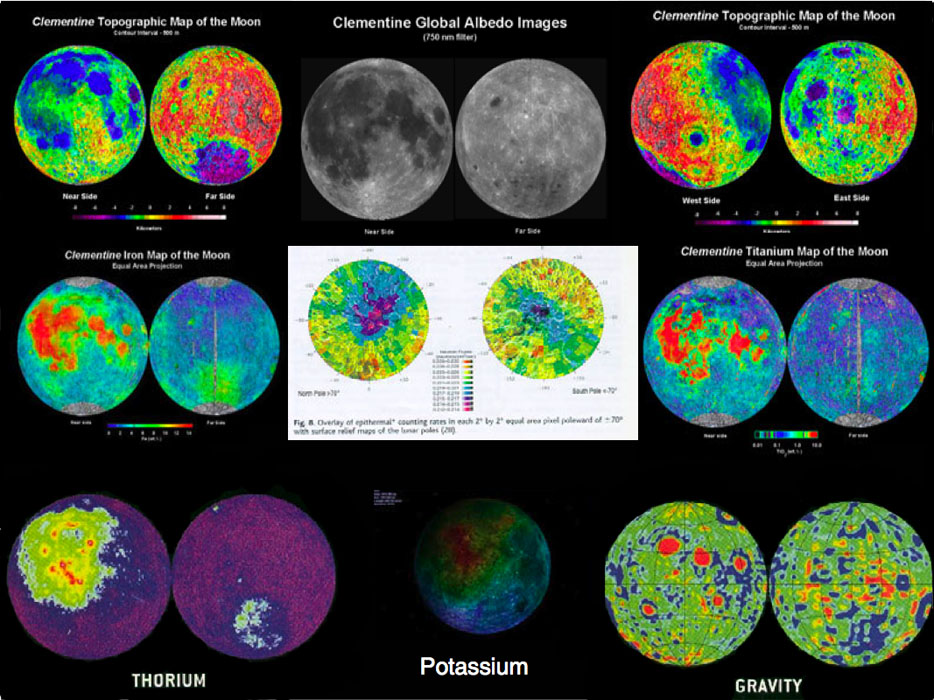Difference between revisions of "October 5, 2008"
| Line 6: | Line 6: | ||
<em>image from [http://sci2.esa.int/Conferences/ILC2005/Presentations/BhandariN-01-PPT.pdf N. Bhandari], Ahmedabad, India</em><br /> | <em>image from [http://sci2.esa.int/Conferences/ILC2005/Presentations/BhandariN-01-PPT.pdf N. Bhandari], Ahmedabad, India</em><br /> | ||
<br /> | <br /> | ||
| − | I've heard that elephants have eyes that are sensitive deeper into the far red than humans, so their view of the world differs at least a little from ours. Scientific sensors have been created to expand human vision to see things not visible to our eyes. This collection of lunar globes, included within a fascinating [http://sci2.esa.int/Conferences/ILC2005/Presentations/BhandariN-01-PPT.pdf presentation] about the soon-to-be launched Chandrayaan-1 lunar orbiter, uses various sensors and combinations of their imagery to map important physical characteristics of our Moon. Most of the data come from Clementine and Lunar Prospector orbiters. The two black & white images are the near and farside approximately visual views; most of the other image pairs have the same arrangement. The top left and right color pairs are lunar [ | + | I've heard that elephants have eyes that are sensitive deeper into the far red than humans, so their view of the world differs at least a little from ours. Scientific sensors have been created to expand human vision to see things not visible to our eyes. This collection of lunar globes, included within a fascinating [http://sci2.esa.int/Conferences/ILC2005/Presentations/BhandariN-01-PPT.pdf presentation] about the soon-to-be launched Chandrayaan-1 lunar orbiter, uses various sensors and combinations of their imagery to map important physical characteristics of our Moon. Most of the data come from Clementine and Lunar Prospector orbiters. The two black & white images are the near and farside approximately visual views; most of the other image pairs have the same arrangement. The top left and right color pairs are lunar [[November_1,_2006|Procellarum KREEP Terrain]], which is best defined by the excess thorium at bottom left, but is also shown by concentrations of iron, titanium and potassium. These 17 circles of information will soon be updated by higher resolution elemental and topographic data from Chandrayaan-1, Selene, Chang'e-1, and Lunar Reconnaissance Orbiter.<br /> |
<br /> | <br /> | ||
<em>[mailto:tychocrater@yahoo.com Chuck Wood]</em><br /> | <em>[mailto:tychocrater@yahoo.com Chuck Wood]</em><br /> | ||
Latest revision as of 21:24, 22 March 2015
Many Moons

image from N. Bhandari, Ahmedabad, India
I've heard that elephants have eyes that are sensitive deeper into the far red than humans, so their view of the world differs at least a little from ours. Scientific sensors have been created to expand human vision to see things not visible to our eyes. This collection of lunar globes, included within a fascinating presentation about the soon-to-be launched Chandrayaan-1 lunar orbiter, uses various sensors and combinations of their imagery to map important physical characteristics of our Moon. Most of the data come from Clementine and Lunar Prospector orbiters. The two black & white images are the near and farside approximately visual views; most of the other image pairs have the same arrangement. The top left and right color pairs are lunar Procellarum KREEP Terrain, which is best defined by the excess thorium at bottom left, but is also shown by concentrations of iron, titanium and potassium. These 17 circles of information will soon be updated by higher resolution elemental and topographic data from Chandrayaan-1, Selene, Chang'e-1, and Lunar Reconnaissance Orbiter.
Chuck Wood
Yesterday's LPOD: A Loooong Lunar Exposure
Tomorrow's LPOD: The Other Side
COMMENTS?
Register, Log in, and join in the comments.



